Situated near the iconic Red Rocks Amphitheater, the Colorado Music Hall of Fame is a museum that showcases the state’s rich musical heritage.
From exploring the legacies of renowned artists like John Denver and the studio haven of Caribou Ranch to delving into the pioneering AAA format, you’ll gain a deep understanding of the artists and institutions that have shaped the Colorado music scene over the decades.
Below, I’ll provide you with an overview of what to expect when you visit the Colorado Music Hall of Fame, including a glimpse of some of the highlights.
Table of Contents
What is the Colorado Music Hall of Fame?
The Colorado Music Hall of Fame is a small museum dedicated to recognizing and honoring the remarkable contributions of musicians and institutions who have made a profound impact on the Colorado music scene.
Through captivating exhibits and prestigious inductions, the Hall of Fame showcases Colorado’s rich musical legacy, enlightening and inspiring the public with its storied music history.
Where is the Colorado Music Hall of Fame?
The Colorado Music Hall of Fame is conveniently located within Red Rocks Park, just a brief stroll away from the renowned Red Rocks Amphitheater. Situated in the Trade Post building, which also houses the Red Rocks Theater gift shop, the museum is a must-see for music lovers when visiting Red Rocks Park.
It’s open every day except Thanksgiving and Christmas from 10 AM to 6 PM but you might want to check for the latest hours just in case. The address you want to put in your GPS is: 17900 Trading Post Rd, Morrison, CO 80465.
When it comes to parking, numerous large lots are available throughout Red Rocks Park. However, there is a parking lot situated directly outside the museum, offering added convenience. There’s also a handful of electric vehicle parking spaces, which we were able to take advantage of.
Standard parking is free and there is no admission fee to the museum, so this can be a 100% free experience.
However, if you’d like to support the museum, consider making a donation. Every little bit helps!

Visiting the Colorado Music Hall of Fame
Arriving a couple of hours before the museum opened, we embarked on the Trading Post Trail, a picturesque 1.5-mile round-trip loop hike with an elevation gain of approximately 357 feet. This scenic trail proved to be a perfect way to kick-start our day, offering breathtaking views and a refreshing dose of nature.
The hike struck a delightful balance, providing an easy to moderate challenge that got our blood pumping without pushing us to the limits of exhaustion.

As we ventured along the trail, we were greeted by the sight of deer peacefully grazing below us.
Along the way, we also delved into the captivating geology of the area, a journey through 300 million years of geological history. Discovering the ancient forces that shaped the landscape kept us in awe of the immense timescale involved in this tectonic artistry.
Moreover, we learned about the distinctive names given to the iconic rocks that comprise the park. From the intriguing “Sinking Titanic” to the majestic “Creation Rock,” each name infused the landscape with a sense of wonder and character, highlighting the geological features that make this place so special.
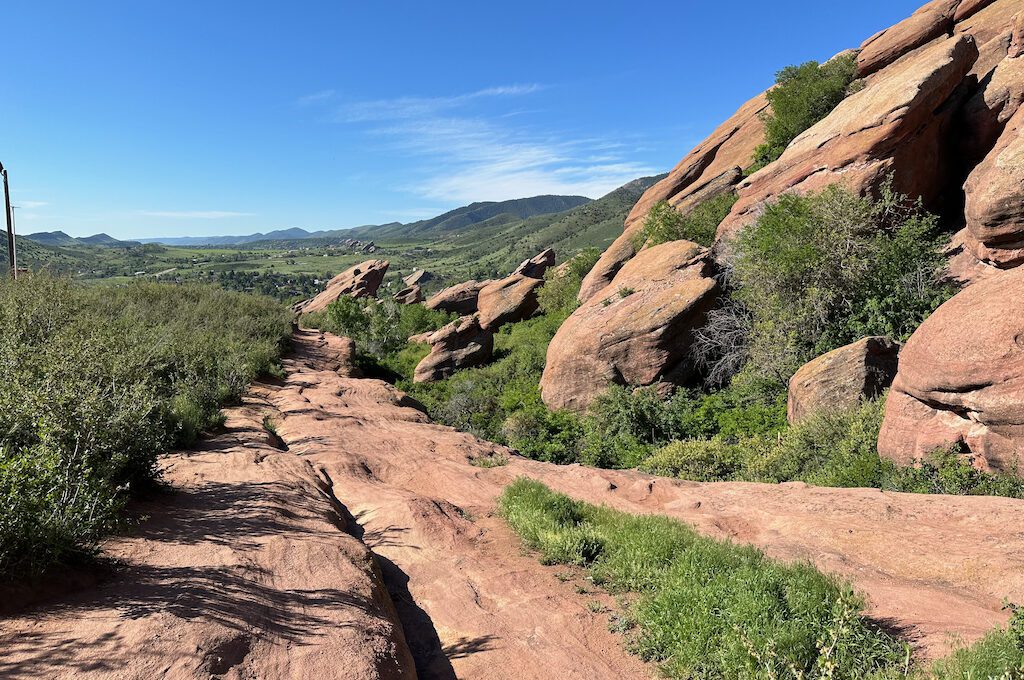
As we neared the end of our hike, we couldn’t resist the allure of the legendary Red Rocks Amphitheater, an iconic landmark we were visiting for the first time. So we took a detour to check out the amphitheater.
Following this route, you may find your legs put to the test as you ascend to the amphitheater, especially if you’re not acclimated to the high elevation. Though the hike + ascent may challenge you some, the experience and breathtaking views are well worth the effort, so just take your time!

During the morning and early afternoon, Red Rocks Amphitheater becomes a bustling hub for fitness enthusiasts. You’ll witness people from all walks of life engaging in invigorating workouts, jogging up and down the steps, and traversing the expansive area.
Because the museum highlights a lot of Red Rocks Amphitheater, I think it’s a good idea to check out the amphitheater before you visit the museum as it gives you a better sense of appreciation for the venue.

Finally, after some nice moderate exercise in the outdoors, we arrived at the Colorado Music Hall of Fame.
It’s housed in the Trade Post building, a historic structure built in 1931 in a Pueblo Revival style to “commemorate the Native American form of architecture and to harmonize with the surrounding landscape.”

Upon arrival, you’ll likely enter through the main doors of the Trade Post building, leading you directly into the Red Rocks gift shop. Inside, you’ll discover a wide array of souvenirs, ranging from magnets and postcards to an assortment of T-shirts, catering to every taste. Some cozy beanies and socks could be had too.

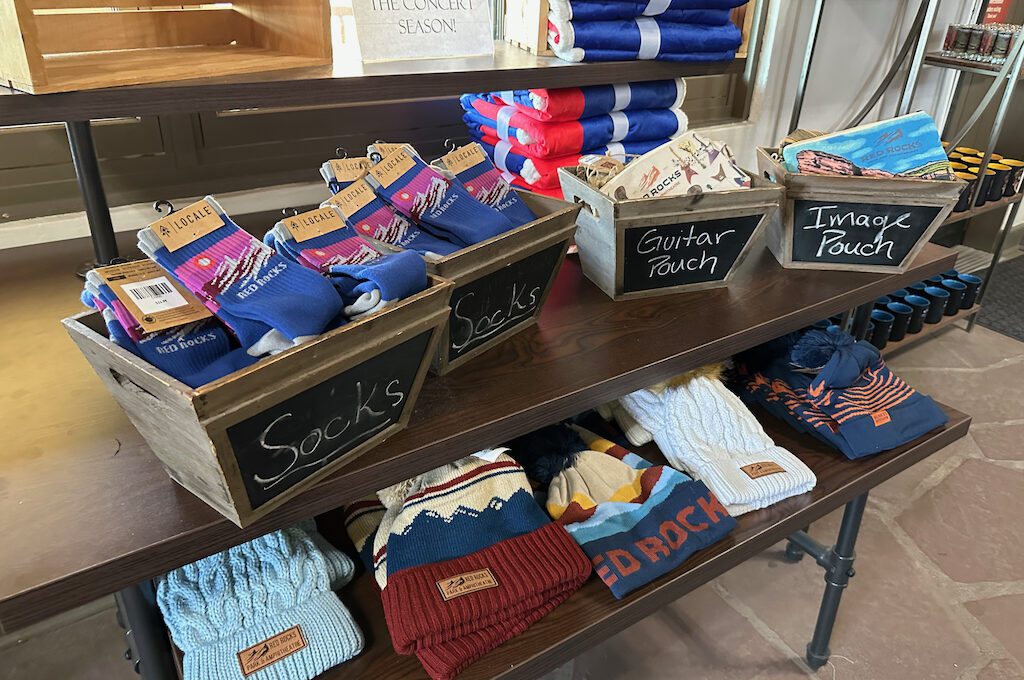
From inside the gift shop, you’ll see some exhibits for the Colorado Music Hall of Fame.
You’ll find exhibits for the various classes inducted into the Hall of Fame over the years since 2011 and you can always just look to the top corner of the exhibit to see which class you’re looking at.
Of course, the main exhibit hall at the Colorado Music Hall of Fame is dedicated primarily to the one and only John Denver, known for his music that celebrated the natural beauty of Colorado. Learn about his rise to prominence with various exhibits and artifacts including some of his plaque awards, wardrobe pieces, and a custom-made guitar.
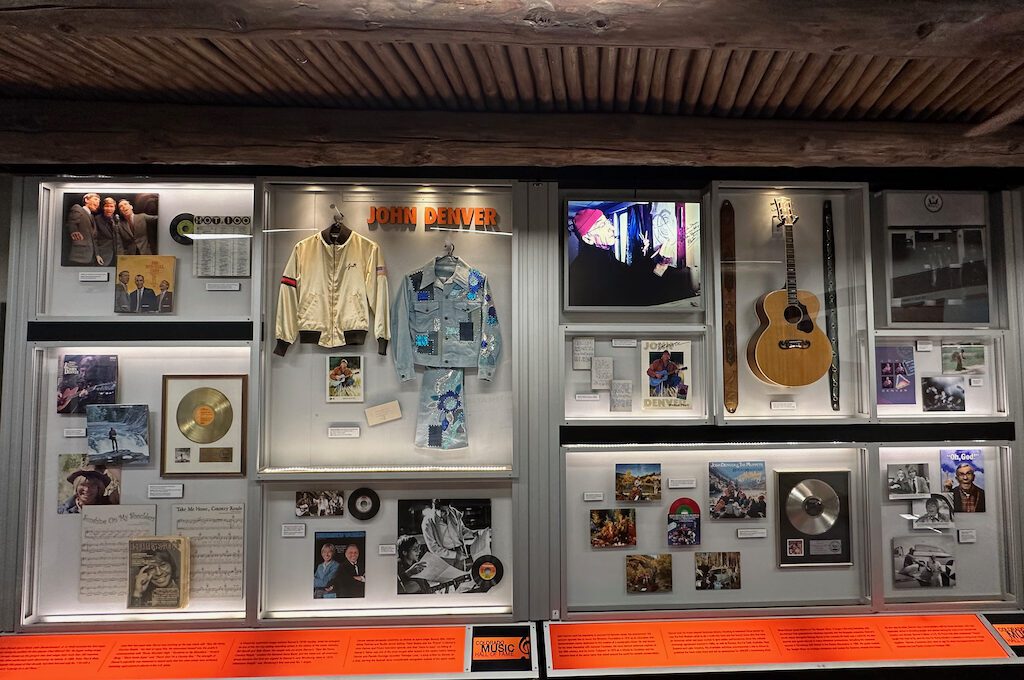
In this room, you’ll also find a dedicated feature on the Red Rocks Amphitheater, which holds the distinction of being the second member of the inaugural class.
Delving into its history, we uncovered intriguing facts about the park’s beginnings, unveiling its earlier identities as the “Garden of the Angels” and the “Garden of the Titans.” It seems that the name transition was believed to carry a certain curse, though the current status of this belief remains uncertain.
A noteworthy coincidence was our visit on May 30, coinciding with the date of the first recorded concert at the park way back in 1906! Pretty cool.

You’ll be able to get a sense of the evolution of the park and the insane amount of work that the Civilian Conservation Corps (CCC) “boys” put into constructing the theater while working for $1 a day and room and board.
They blew up rocks, and worked mostly with picks and shovels, as they built out the amphitheater with seating for more than 9,000 over the span of 12 years.
After checking out the inaugural class, we made our way to the other side of the museum which goes into a lot of different classes spanning the different decades.
We discovered pioneering concert promoters such as Chuck Morris, who successfully lured established performers like AC/DC, Bob Dylan and Metallica, and U2.
I appreciated learning the history of KBCO, which helped to pioneer the Adult Album Alternative (or Triple A) format — a radio format tailored for adults and characterized by expansive and diverse playlists that transcend the confines of mainstream hit stations.
Equally captivating was delving into the annual Studio C series, a tradition that showcased electrifying live recordings by highly esteemed visiting performers including the Goo Goo Dolls, Jeff Buckley, the Doobie Brothers, and many, many more.
These hall of fame museums have exhibits that are fun to check out but they are also great for discovering new artists and styles of music you might enjoy. I enjoyed getting familiar with oldies bands I had never heard of like The Astronauts, the “premier landlocked Midwestern surf group” of the ’60s. They were huge in Japan.
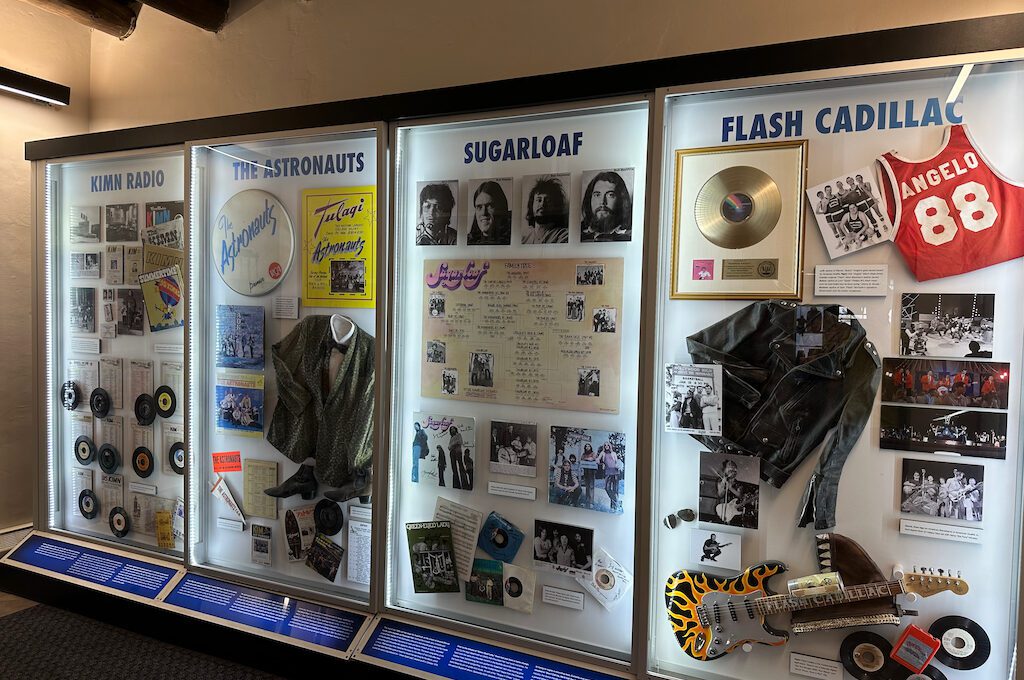
Finally, it was also really cool to learn about Caribou Ranch, part of the class of 2017.
It was a studio tucked away in the mountains near Nederland, Colorado, where artists did not have to deal with a lot of the distractions during recording sessions such as going to get food, getting to and from the hotel, etc. The thin air at nearly 9,000 feet also reportedly allowed artists to produce a unique sound.
This idyllic setting served as a catalyst for creativity, attracting renowned musicians such as Michael Jackson, Elton John, Dan Fogelberg, Joe Walsh, Chicago, the Beach Boys, and numerous others, who found inspiration and produced memorable works within its walls.
Unfortunately, it went down in flames in the 1980s but it’s legacy lives on!
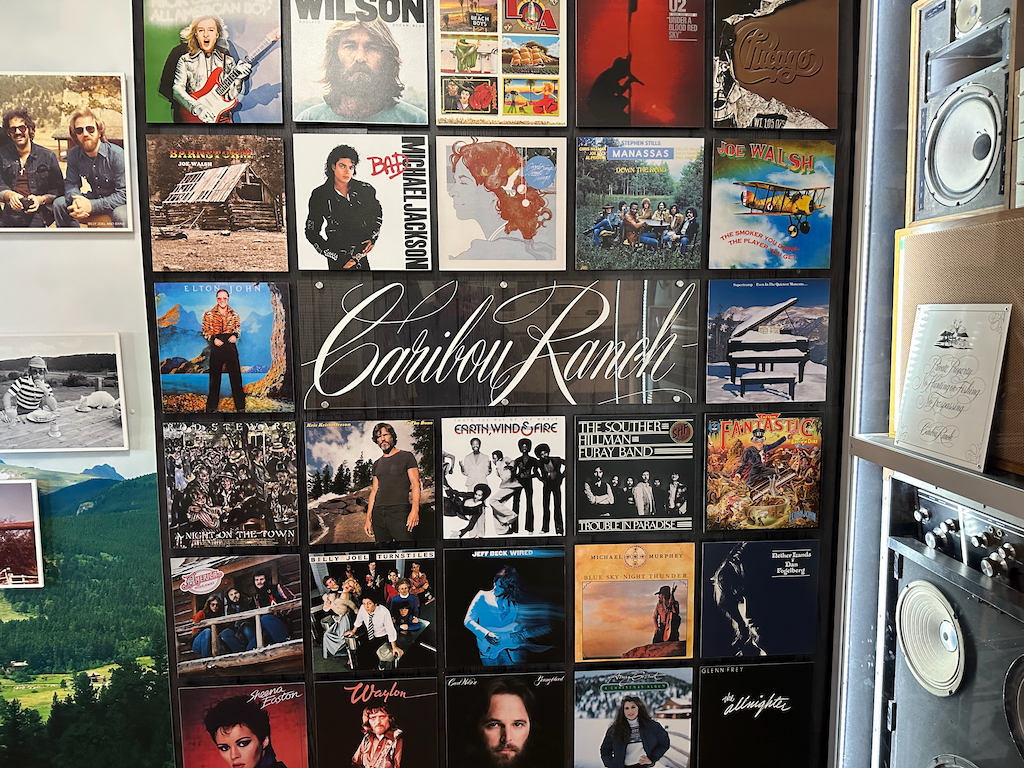
After checking out all of the Hall of Fame exhibits, we ventured outside onto the beautiful patio area with some amazing views of the red rocks.
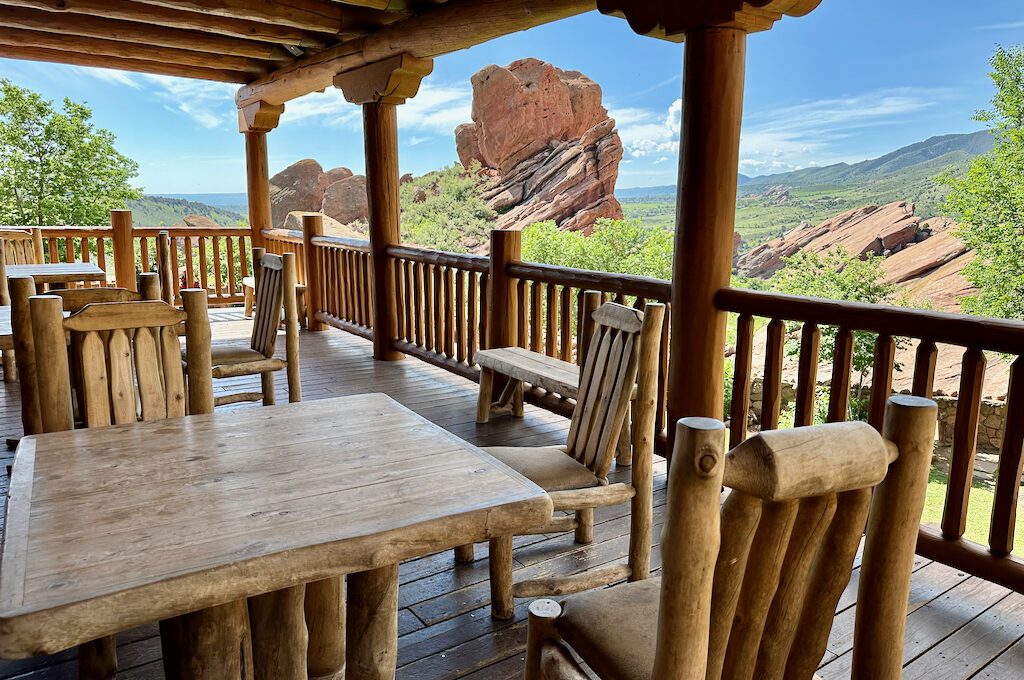
You can also venture down to check out a cool water feature and more views.

After that, we decided to do a little bit more exploring of the red rocks and so we drove up to the geological marker where there are fantastic views of the surrounding foothills and even the Denver skyline.
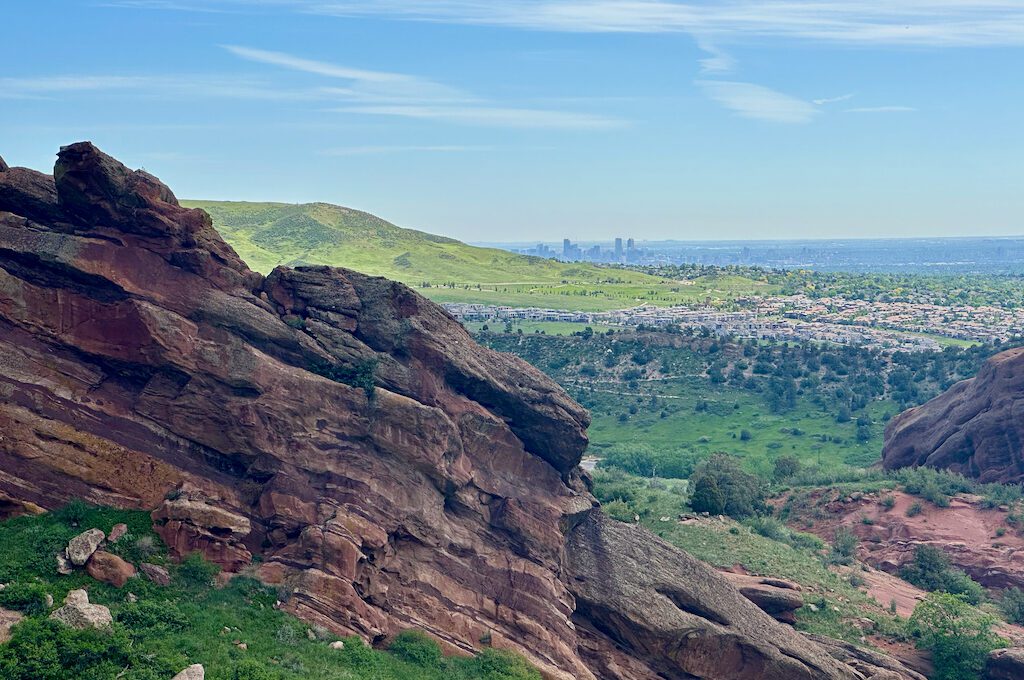
We had a really good view of the west side of Dinosaur Ridge which we had just explored the week prior. I’d highly recommend you give it a stop because you can see the best dinosaur track site in the nation along with other cool fossils and track sites. They offer tours but you can also see all of it for free on foot.
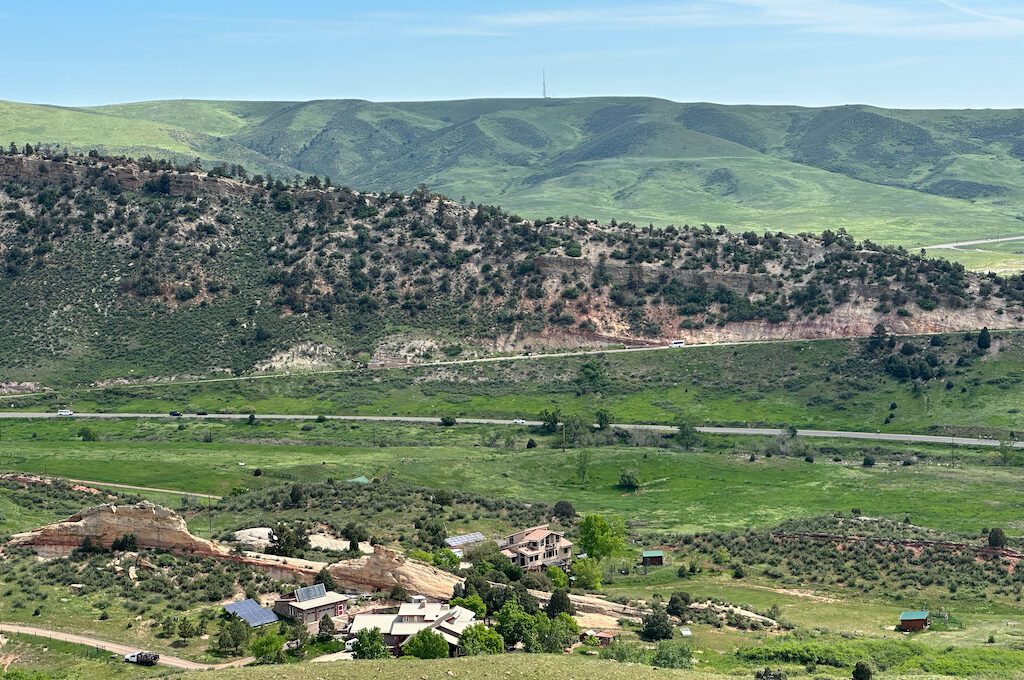
Final word
If you ever plan on visiting the Red Rocks Amphitheater, you might as well spend about 30 minutes to one hour checking out the Colorado Music Hall of Fame.
For people like myself who don’t know a lot about the Colorado music scene, it’s a very interesting museum to explore, and you’ll come away with a wealth of knowledge about the artists and various institutions that have played a major role in shaping the music legacy of the state.
Daniel Gillaspia is the Founder of UponArriving.com and the credit card app, WalletFlo. He is a former attorney turned travel expert covering destinations along with TSA, airline, and hotel policies. Since 2014, his content has been featured in publications such as National Geographic, Smithsonian Magazine, and CNBC. Read my bio.

